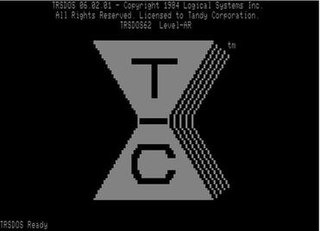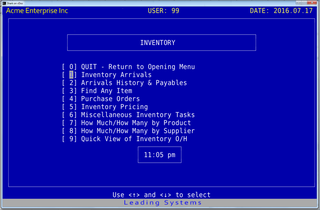File Allocation Table (FAT) is a file system developed for personal computers. Originally developed in 1977 for use on floppy disks, it was adapted for use on hard disks and other devices. It is often supported for compatibility reasons by current operating systems for personal computers and many mobile devices and embedded systems, allowing interchange of data between disparate systems. The increase in disk drives capacity required three major variants: FAT12, FAT16 and FAT32. The FAT standard has also been expanded in other ways while generally preserving backward compatibility with existing software.
A text file is a kind of computer file that is structured as a sequence of lines of electronic text. A text file exists stored as data within a computer file system. In operating systems such as CP/M and MS-DOS, where the operating system does not keep track of the file size in bytes, the end of a text file is denoted by placing one or more special characters, known as an end-of-file marker, as padding after the last line in a text file. On modern operating systems such as Microsoft Windows and Unix-like systems, text files do not contain any special EOF character, because file systems on those operating systems keep track of the file size in bytes. Most text files need to have end-of-line delimiters, which are done in a few different ways depending on operating system. Some operating systems with record-orientated file systems may not use new line delimiters and will primarily store text files with lines separated as fixed or variable length records.

dBase was one of the first database management systems for microcomputers and the most successful in its day. The dBase system includes the core database engine, a query system, a forms engine, and a programming language that ties all of these components together. dBase's underlying file format, the .dbf file, is widely used in applications needing a simple format to store structured data.

Newline is a control character or sequence of control characters in a character encoding specification that is used to signify the end of a line of text and the start of a new one, e.g., Line Feed (LF) in Unix. Some text editors set this special character when pressing the ↵ Enter key.
Clipper is an xBase compiler that implements a variant of the xBase computer programming language. It is used to create or extend software programs that originally operated primarily under MS-DOS. Although it is a powerful general-purpose programming language, it was primarily used to create database/business programs.
Disk formatting is the process of preparing a data storage device such as a hard disk drive, solid-state drive, floppy disk or USB flash drive for initial use. In some cases, the formatting operation may also create one or more new file systems. The first part of the formatting process that performs basic medium preparation is often referred to as "low-level formatting". Partitioning is the common term for the second part of the process, dividing the device into several sub-devices and, in some cases, writing information to the device allowing an operating system to be booted from it. The third part of the process, usually termed "high-level formatting" most often refers to the process of generating a new file system. In some operating systems all or parts of these three processes can be combined or repeated at different levels and the term "format" is understood to mean an operation in which a new disk medium is fully prepared to store files. Some formatting utilities allow distinguishing between a quick format, which does not erase all existing data and a long option that does erase all existing data.
In computer programming, the term magic number has multiple meanings. It could refer to one or more of the following:
Clarion is a commercial, proprietary, fourth-generation programming language (4GL), multi-paradigm, programming language and integrated development environment (IDE) from SoftVelocity used to program database applications. It is compatible with indexed sequential access method (ISAM), Structured Query Language (SQL), and ActiveX Data Objects (ADO) data access methods, reads and writes several flat file desktop database formats including ASCII, comma-separated values (CSV), DOS (binary), FoxPro, Clipper, dBase, and some relational databases via ODBC, Microsoft SQL Server, Sybase SQL Anywhere, and Oracle Database through the use of accelerated native database drivers, and XML, Clarion can be used to output to HTML, XML, plain text, and Portable Document Format (PDF), among others.

TRSDOS is the operating system for the Tandy TRS-80 line of eight-bit Zilog Z80 microcomputers that were sold through Radio Shack from 1977 through 1991. Tandy's manuals recommended that it be pronounced triss-doss. TRSDOS should not be confused with Tandy DOS, a version of MS-DOS licensed from Microsoft for Tandy's x86 line of personal computers (PCs).
A fat binary is a computer executable program or library which has been expanded with code native to multiple instruction sets which can consequently be run on multiple processor types. This results in a file larger than a normal one-architecture binary file, thus the name.
A FourCC is a sequence of four bytes used to uniquely identify data formats. It originated from the OSType or ResType metadata system used in classic Mac OS and was adopted for the Amiga/Electronic Arts Interchange File Format and derivatives. The idea was later reused to identify compressed data types in QuickTime and DirectShow.
A hex editor is a computer program that allows for manipulation of the fundamental binary data that constitutes a computer file. The name 'hex' comes from 'hexadecimal', a standard numerical format for representing binary data. A typical computer file occupies multiple areas on the storage medium, whose contents are combined to form the file. Hex editors that are designed to parse and edit sector data from the physical segments of floppy or hard disks are sometimes called sector editors or disk editors.
The Microsoft Jet Database Engine is a database engine on which several Microsoft products have been built. The first version of Jet was developed in 1992, consisting of three modules which could be used to manipulate a database.

VP-Info is a database language and compiler for the personal computer. VP-Info was a competitor to the Clipper and dBase applications in the late 1980s and 1990s. VP-Info runs on MS-DOS, DR-DOS and the PC-MOS/386 operating system. The last release of VP-Info was named Shark.

The shapefile format is a geospatial vector data format for geographic information system (GIS) software. It is developed and regulated by Esri as a mostly open specification for data interoperability among Esri and other GIS software products. The shapefile format can spatially describe vector features: points, lines, and polygons, representing, for example, water wells, rivers, and lakes. Each item usually has attributes that describe it, such as name or temperature.
Intel hexadecimal object file format, Intel hex format or Intellec Hex is a file format that conveys binary information in ASCII text form. It is commonly used for programming microcontrollers, EPROMs, and other types of programmable logic devices. In a typical application, a compiler or assembler converts a program's source code to machine code and outputs it into a HEX file. Common file extensions used for the resulting files are .HEX or .H86. The HEX file is then read by a programmer to write the machine code into a PROM or is transferred to the target system for loading and execution.
The DOS MZ executable format is the executable file format used for .EXE files in DOS.

Motorola S-record is a file format, created by Motorola, that conveys binary information as hex values in ASCII text form. This file format may also be known as SRECORD, SREC, S19, S28, S37. It is commonly used for programming flash memory in microcontrollers, EPROMs, EEPROMs, and other types of programmable logic devices. In a typical application, a compiler or assembler converts a program's source code to machine code and outputs it into a HEX file. The HEX file is then imported by a programmer to "burn" the machine code into non-volatile memory, or is transferred to the target system for loading and execution.
A FAT file system is a specific type of computer file system architecture and a family of industry-standard file systems utilizing it.
The Esri TIN format is a popular yet proprietary geospatial vector data format for geographic information system (GIS) software for storing elevation data as a triangulated irregular network. It is developed and regulated by Esri. The Esri TIN format can spatially describe elevation information including breaking edge features. Each points and triangle can carry a tag information. A TIN stored in this file format can have any shape, cover multiple regions and contain holes.






